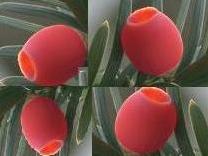Yew and Paclitaxel
What Do They Have in Common?

The Bottom Line
Just because something is "natural", it isn't necessarily safe to casually eat or use. Originally, all remedies came from nature. Yew is an example of a plant with medicinal value that can be poisonous if eaten.

The Full Story
Yew is a popular landscaping shrub. In the fall, the bright red berries are especially attractive. Poisonous parts of the plant include the needles and the seed found inside the berries. Children have been poisoned by eating berries and adults by brewing tea from the needles. The fleshy red part of the berry is considered edible by some.
The botanical name for this plant is Taxus; there are several varieties. The Pacific yew, Taxus brevifolia, was the original source of the drug paclitaxel, known to many by its original brand name Taxol®. This drug is used to treat some kinds of cancer, including ovarian cancer and breast cancer.
This is a reminder that:
- Originally, all remedies came from nature. Then and now, care must be taken to use medicines safely.
- Just because something is "natural", it isn't necessarily safe to casually eat or use. (Poison specialists caution that arsenic, cyanide, and strychnine are among the many "natural" substances that can be misused!).
Rose Ann Gould Soloway, RN, BSN, MSEd, DABAT emerita
Clinical Toxicologist
Poisoned?
Call 1-800-222-1222 or
Prevention Tips
Watch children carefully when they're playing outdoors. If a child eats a plant, consult Poison Control right away; don't wait to see if symptoms will occur.This Really Happened
Case 1: A 2-year-old boy ate an unknown number of red berries from an unknown bush. He developed persistent nausea and vomiting. Three days after he ate the berries, his mom took him to the pediatrician, who called Poison Control. The poison specialist advised 1) certain blood work; 2) identification of the plant; and 3) transfer to an emergency room because of the child's symptoms. The family identified the bush as a yew. The emergency physician consulted Poison Control and noted that two intact berries were found in the child's diaper. The child's vomiting decreased and he began drinking fluids with less trouble. After further observation, the child was sent home. By the next day, the grandmother reported to Poison Control that the little boy had improved and was able to keep down fluids much better.
Case 2: A health care worker spilled paclitaxel, a drug used to treat some forms of cancer, on her skin. She immediately began washing the areas with water and called Poison Control. Skin exposure to this drug may cause irritation, rash and itching. Poison Control advised continuing to thoroughly flush the area until she could get into a shower. She followed this advice, observed the skin areas over the next few days, and did not develop symptoms.
References
Grobosch T, Schwarze B, Felgenhauer N, Riesselmann B, Roscher S, Binscheck T. Eight cases of fatal and non-fatal poisoning with Taxus baccata. Forensic Sci Int. 2013;227(1-3):118-26. doi: 10.1016/j.forsciint.2012.11.014. Epub 2012 Dec 21.
Lee S-G, Ambados F, Tkaczuk M, Jankewicz G. Paclitaxel exposure and its effective decontamination. J Pharm Pract Res. 2009;39:181-5.
Poisoned?
Call 1-800-222-1222 or
Prevention Tips
Watch children carefully when they're playing outdoors. If a child eats a plant, consult Poison Control right away; don't wait to see if symptoms will occur.This Really Happened
Case 1: A 2-year-old boy ate an unknown number of red berries from an unknown bush. He developed persistent nausea and vomiting. Three days after he ate the berries, his mom took him to the pediatrician, who called Poison Control. The poison specialist advised 1) certain blood work; 2) identification of the plant; and 3) transfer to an emergency room because of the child's symptoms. The family identified the bush as a yew. The emergency physician consulted Poison Control and noted that two intact berries were found in the child's diaper. The child's vomiting decreased and he began drinking fluids with less trouble. After further observation, the child was sent home. By the next day, the grandmother reported to Poison Control that the little boy had improved and was able to keep down fluids much better.
Case 2: A health care worker spilled paclitaxel, a drug used to treat some forms of cancer, on her skin. She immediately began washing the areas with water and called Poison Control. Skin exposure to this drug may cause irritation, rash and itching. Poison Control advised continuing to thoroughly flush the area until she could get into a shower. She followed this advice, observed the skin areas over the next few days, and did not develop symptoms.
